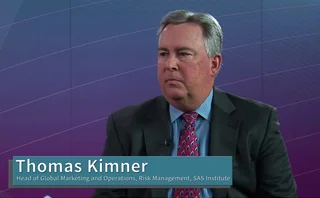
The main challenge remains the same
Lance Uggla, chief executive of Mark-It Partners, says his company’s competitive edge is its immaculate data set. By Oliver Holtaway

As chief executive, Uggla faces his own stiff competition – from rival financial information heavyweights such as Reuters, Thomson Financial and Bloomberg. But data provider Mark-it Partners has shown its willingness to take on the big boys at their own game, selling data directly to end-users rather than taking perhaps the easier road of licensing its data to the platform providers. Uggla says: “Our largest rivals have a competitive edge through their platforms. Our competitive edge is our clean, complete, accurate content.”
And the importance of a clean data set is being felt more keenly than ever by market participants, he argues. “In the current US regulatory environment, you can go to jail if you sign off on a set of accounts. You need independent data for peace of mind,” he says.
Vancouver-born Uggla has been involved in credit for long enough to see the demand for reliable price information grow and grow. He was awarded an MA in accounting and finance from the London School of Economics in 1986 and graduated straight into the frenzied recruitment drives of the Big Bang era. But despite being interviewed for several positions at US investment banks’ London offices, visa problems saw him return to Canada, where he took a job in Toronto as a mortgage-backed securities trader at Wood Gundy, an old, established Canadian investment bank. Soon after, Wood Gundy was bought by CIBC. By 1995, Uggla had risen to head of debt capital markets.
At this point, says Uggla, the credit derivatives market was in its embryonic stage, and “people didn’t really think of ‘credit’ per se.” Uggla, however, took an interest in bringing fixed income and derivatives together.
He joined Toronto Dominion’s London office in March 1995, bringing his wife and three children to the UK (his fourth child was born in his adopted home town of St Albans). Here, Uggla ran Toronto Dominion’s European and Asian credit business, with a specific aim of developing the global credit trading capability.
Toronto Dominion’s presence in the credit markets was substantial, given that it was a medium-sized regional bank. Crucially, says Uggla, “it was an institution that early on put cash and derivatives trading groups together and properly integrated them”.
While running Toronto Dominion’s global credit trading group, Uggla approached the big investment banks to provide Toronto Dominion with daily price data. “As we were good customers of theirs, they agreed,” he says. It was this arrangement, formed in 1999, that provided the seed of the idea for Mark-it Partners. The credit markets were growing exponentially and other banks had the same data needs as Toronto Dominion. They too needed to back up their investment and trading decisions with a robust data set.
Uggla approached Toronto Dominion chief executive Don Wright with the idea of setting up an independent provider of price data. “The data has always been there,” says Uggla, “but there was no clear multi-dealer consensus that was properly cleaned and maintained.” Wright liked the idea, and Toronto Dominion took the initial risk of setting it up. The official spin-off of Mark-it Partners from Toronto Dominion took place in 2002.
Today, Mark-it Partners has more than 250 customers. Hedge funds have been a strong driver of growth over the last year. Mark-it Partners has also expanded through a series of acquisitions. The next move? Daily prices for asset-backed and mortgage-backed securities.
This article originally appeared in the December 2004 issue of Credit magazine
Only users who have a paid subscription or are part of a corporate subscription are able to print or copy content.
To access these options, along with all other subscription benefits, please contact info@risk.net or view our subscription options here: http://subscriptions.risk.net/subscribe
You are currently unable to print this content. Please contact info@risk.net to find out more.
You are currently unable to copy this content. Please contact info@risk.net to find out more.
Copyright Infopro Digital Limited. All rights reserved.
As outlined in our terms and conditions, https://www.infopro-digital.com/terms-and-conditions/subscriptions/ (point 2.4), printing is limited to a single copy.
If you would like to purchase additional rights please email info@risk.net
Copyright Infopro Digital Limited. All rights reserved.
You may share this content using our article tools. As outlined in our terms and conditions, https://www.infopro-digital.com/terms-and-conditions/subscriptions/ (clause 2.4), an Authorised User may only make one copy of the materials for their own personal use. You must also comply with the restrictions in clause 2.5.
If you would like to purchase additional rights please email info@risk.net
More on Infrastructure
Communications surveillance solutions 2024: market update
A report offering Chartis’ latest view of the vendor landscape for communications surveillance solutions
SIMONE, the AI that nearly took down a bank
An algorithm designed to create new structured products ran out of control last year with almost catastrophic consequences for a major bank, as our exclusive whistleblower account reveals
Revealed: where banks are (literally) warehousing their swaps
As derivatives notional grows, dealers experiment with novel storage solutions
E-trading takes hold for FX swaps – sort of
Bulk of trades are being executed over screen, but bolder changes have stalled
From DNA to DHA – Preparing for a new era of digital human augmentation
As technology increasingly permeates societies, cultures and everyday activities, its integration into people’s lives is having a profound impact on what is expected of people in the workplace. Deloitte examines this evolution of today’s workforce, the…
Risk and finance: Working more closely together
Video interview: Thomas Kimner, SAS
Video interview: Fabio Merlino, Intesa Sanpaolo
Fabio Merlino, head of retail and insurance risk discusses how the wealth management division of Intesa Sanpaolo upgraded its risk analytics capabilities with the algo system used by its proprietary traders
The changing face of Risk.net and our magazines
Extensive reader consultation has helped us reshape editorial teams and our site







